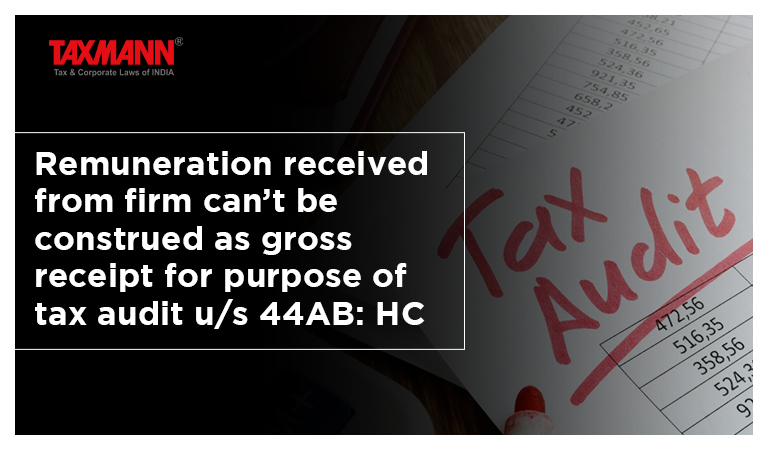Remuneration received from firm can’t be construed as gross receipt for purpose of tax audit u/s 44AB: HC
- News|Blog|Income Tax|
- 2 Min Read
- By Taxmann
- |
- Last Updated on 22 June, 2022
Case Details: Perizad Zorabian Irani v. PCIT - [2022] 139 taxmann.com 164 (Bombay)
Judiciary and Counsel Details
-
- K.R. Shriram & N.J. Jamadar, JJ.
- Dr. K. Shivram, Sr. Adv. for the Petitioner.
- Suresh Kumar for the Respondent.
Facts of the Case
Assessee was an actor and also a partner in two partnership firms. During AY 2017-18, she declared Rs. 1,09,65,411 under the head of business and profession. Out of this declared income, Rs. 8,45,220 was from acting profession and Rs. 1,01,20,191 was remuneration received from the partnership firm.
The Assessing Officer (AO) rejected the return of income (ITR) treating it as invalid as she failed to get her accounts audited in accordance with provisions of section 44AB.
The assessee submitted that the provisions of section 44AB are not applicable because partners’ remuneration cannot be construed as total sales turnover or gross receipts in business or profession. However, lower authority upheld the order of AO. Assessee approached before the High Court.
High Court Held
The Bombay High Court held that clause (b) of section 44AB provides that every person carrying on profession shall if his gross receipts in profession exceed Rs. 50 lakh in any previous year, get his accounts of such previous year audited by an accountant.
The profession is defined under section 2(36) as “Profession includes vocation”. The income earned by the assessee as remuneration received as a working partner cannot be held as carrying on profession.
The Madras High Court in the case of Anandkumar v. ACIT [2020] 122 taxmann.com 252 (Madras) also held that remuneration and interest received by the individual assessee from the partnership firm cannot be termed to be a turnover of the assessee.
Considering the fact that the assessee was only a partner in a partnership firm and was not carrying on any business independently, remuneration received by her from said partnership firm could not be treated as gross receipts of the assessee. Accordingly, she was justified in not getting her accounts audited under section 44AB with respect to such remuneration.
List of Cases Referred to
-
- Amal Ganguli v. Dy. CIT [IT Appeal No. 2135 (Kol.) of 2008, dated 20-2-2009] (para 5)
- Sagar Dutta v. CIT [2014] 44 taxmann.com 311 (Cal.) (para 5)
- Anandkumar v. Asstt. CIT [2020] 122 taxmann.com 252/[2021] 278 Taxman 342/403 ITR 391 (Mad.) (para 10).
Disclaimer: The content/information published on the website is only for general information of the user and shall not be construed as legal advice. While the Taxmann has exercised reasonable efforts to ensure the veracity of information/content published, Taxmann shall be under no liability in any manner whatsoever for incorrect information, if any.

Taxmann Publications has a dedicated in-house Research & Editorial Team. This team consists of a team of Chartered Accountants, Company Secretaries, and Lawyers. This team works under the guidance and supervision of editor-in-chief Mr Rakesh Bhargava.
The Research and Editorial Team is responsible for developing reliable and accurate content for the readers. The team follows the six-sigma approach to achieve the benchmark of zero error in its publications and research platforms. The team ensures that the following publication guidelines are thoroughly followed while developing the content:
- The statutory material is obtained only from the authorized and reliable sources
- All the latest developments in the judicial and legislative fields are covered
- Prepare the analytical write-ups on current, controversial, and important issues to help the readers to understand the concept and its implications
- Every content published by Taxmann is complete, accurate and lucid
- All evidence-based statements are supported with proper reference to Section, Circular No., Notification No. or citations
- The golden rules of grammar, style and consistency are thoroughly followed
- Font and size that’s easy to read and remain consistent across all imprint and digital publications are applied






 CA | CS | CMA
CA | CS | CMA


